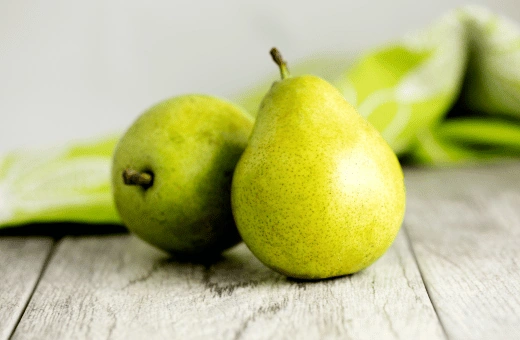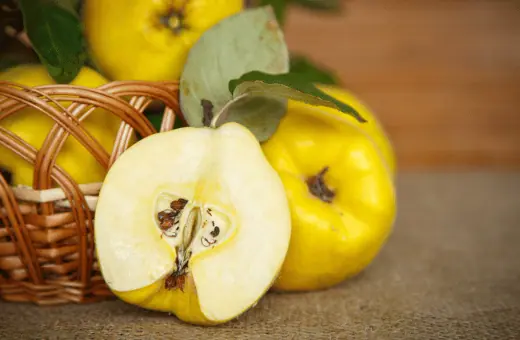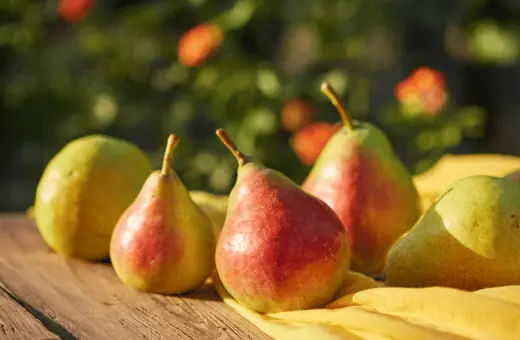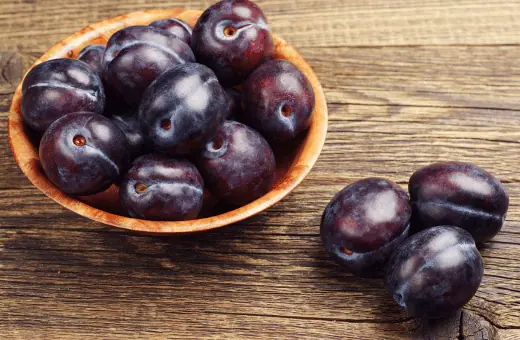Bosc pears are a popular ingredient in a wide variety of sweet and savory dishes, from pies and cakes to salads and soups.
But what happens when you’re in the middle of cooking a recipe that calls for Bosc pears, and you suddenly realize you don’t have any?
But fret not, my fellow cooks, for I have compiled some of the best Bosc pear substitutes that can stand in for Bosc pears and deliver similar texture and flavors, along with helpful tips on how to measure and prepare them.
In short, " What can I use instead of bosc pear?" Anjou Pears, Apples, Asian Pears, Persimmons, Quince, Granny Smith, Apple, Comice Pear, Bartlett Pears, Ripe Plums, Raisins.
What is bosc pear, and what does bosc pear taste like?
Bosc pear is a variety of pear that is distinguished by its firm texture and sweet-tart flavor. It has a light brownish color, with a few vertical russet lines running along the surface.
The flesh of a bosc pear is slightly grainy but still juicy and sweet in taste.
Its distinctively sweet-tart flavor makes it an ideal choice for baking or poaching. With its firm texture, it can also hold up well when cooked or used in salads.
When ripe, bosc pears will have some give when gently pressed at their neck near the stem end. Enjoy this delicious fruit either as a healthy snack or as part of your favorite recipes!
What are the uses of bosc pear?
Bosc pears are often used in cooking to bring out the natural sweetness and complexity of a dish. This fruit has a unique flavor with hints of melon, honey, and spice that can add depth and interest to any recipe.
They are especially popular in pies, tarts, jams, jellies, sauces, cakes, muffins, and other baked goods.
They also make a great addition to salads and sandwiches as they provide an interesting contrast to other ingredients.
The flesh of Bosc pears is firm yet tender when cooked, so they hold their shape well during baking or sautéing.
When buying Bosc pears for cooking, it’s best to look for fruit that is still slightly green and unblemished, as overly ripe ones will be too soft for most recipes.
Some classic uses for Bosc pears include poached pears served with ice cream or crème anglaise; roasted pears topped with blue cheese.
Caramelized pears served with pork tenderloin; pear pies with cinnamon and nutmeg; pear chutney made with raisins; pear puree used in soups or smoothies; and pear-cranberry crisp featuring oats and walnuts.
Best Bosc pear Substitutes
Bosc pears are a popular choice for cooking due to their unique flavor and texture. However, many recipes require a substitute for Bosc pears that can achieve a similar result without sacrificing taste or texture.
Here are 11 of the best substitutes for Bosc pears in various cooking applications:
1. Anjou Pears

Anjou pears are a versatile and popular substitute for Bosc pears, thanks to their similar texture and mild sweetness.
When using Anjou pears as a substitute for Bosc pears, they should be peeled, cored, and sliced to the same size as Bosc pears.
You can also adjust the sugar and spice in your recipe to balance out the slight difference in sweetness.
They are also widely available in grocery stores, so you can easily get them any time of the year. Anjou pears are best in dishes that require a firmer texture, such as pies and tarts.
2. Apples
Apples are another great alternative for Bosc pears, especially when it comes to baking.
Depending on the variety of apples, you can use them in both sweet and savory dishes, and they tend to hold their shape and texture well during cooking.
Granny Smith apples are a popular choice for savory dishes such as stuffing or roasted meats, while sweeter varieties such as Rome, Honeycrisp, and Gala are perfect for cakes, pies, and crisps.
When using apples, make sure to adjust the sugar and spice to suit the variety you choose.
Explore: Top best banana substitutes
3. Asian Pears

Asian pears are a unique and flavorful alternative to Bosc pears, with a crisp, juicy texture and a round shape.
They also have a higher water content than Bosc pears, making them a great choice for use in drinks and cocktails.
When using Asian pears as a substitute, make sure to slice them thinly and use them raw or in lightly cooked dishes to preserve their delicate texture and sweetness.
4. Persimmons
If you’re looking for a substitute for Bosc pears in desserts, persimmons may be your answer. These orange or red fruits have a sweet, earthy flavor and a soft texture when ripe.
They work well in cakes, muffins, and quick bread and can add a creamy, almost pudding-like texture when pureed.
When using persimmons as a substitute for Bosc pears, make sure to use fully ripe, soft fruit and adjust the sugar and spice to cut through their natural sweetness.
5. Quince

Quince is a lesser-known fruit that works well as a substitute for Bosc pears in savory dishes such as stews, roasts, and tagines.
It’s a hard, acidic fruit that needs to be cooked before eating and has a fragrant, floral flavor that pairs well with spices like cinnamon, ginger, and clove.
When using quince as a substitute for Bosc pears, make sure to peel and core them, then simmer them in liquid until tender.
6. Granny Smith Apple
While it might seem strange to use apple instead of pear, the Granny Smith apple is an ideal replacement for Bosc pear in savory dishes.
This apple has a similar texture to Bosc pear and has a tart flavor that pairs well with savory dishes.
Simply peel and dice the apple and use it as you would Bosc pear in your recipe.
7. Comice Pear

For a sweeter alternative to Bosc pear, consider using the Comice pear. This pear has a similar texture to Bosc pear but is sweeter in flavor.
Because of its sweetness, you may need to adjust the amount of sugar in your recipe.
8. Bartlett Pears
Bartlett pears provide a very close match to Bosc pears in terms of both flavor and texture.
While they will still require some adjustment to mimic the acidity of a true Bosc pear, they provide an excellent alternative when making sauces or cobblers requiring more sweetness than tartness.
9. D’Anjou Pears
D’Anjou pears are a crisp but softer variety with enough acidity that can be used interchangeably with Bosc pears in baking recipes or as purees for desserts like ice cream or sorbet.
10. Ripe Plums
Ripe plums offer the same balance between sweet and tart flavors that can be found in most recipes featuring Bosc pears while providing added juiciness.

When cooked down into compotes or tarts, requiring additional moisture content from the fruit being used as an ingredient.
11. Raisins
For recipes calling for dried fruit, raisins make an excellent choice due to their ability to retain moisture during baking processes.
While still offering plenty of natural sweetness without any tartness associated with fresh fruits like Bosc pear varieties do when cooked down into syrups or purees.
Where to buy bosc pear?
There are a few different places you can go. Many specialty food stores carry it, as do some international grocery stores.
You can also order online from many retailers that provide a variety of diverse flavors and types of bosc pear.
Conclusion on bosc pear substitute
Whether you’re out of Bosc pears or looking for a way to mix up your cooking routine, these 11 substitutes are sure to deliver delicious results.
Remember, when substituting ingredients, it’s important to pay attention to flavor, texture, and cooking requirements to ensure your dish comes out just right.
With these tips and tricks, you’ll be able to cook confidently and creatively. Happy cooking!
FAQs on bosc pear substitute
Q1. What is similar to bosc pear?
The most similar pear to a Bosc pear is the Anjou pear. Anjous have a similar oblong shape and smooth, golden-brown skin with a subtle russet blush. They also feature similarly firm and juicy white flesh that has an aromatic fragrance when ripe.
However, unlike Boscs, which are usually mild in flavor, Anjous tend to have a slightly sweet taste and a more pronounced aroma than Boscs. Ultimately, Anjou pears can be used as substitutes for their Bosc relatives in many recipes requiring pears.
Additionally, Bartlett pears may also be considered similar to Bosc varieties since they both share a yellowish-brown color when ripe. Bartletts also have a crisp, juicy texture and sweet flavor. However, unlike Boscs, Bartletts are round in shape.
Despite these small differences, Bartlett pears can be used as an alternative to Bosc varieties for baking and cooking purposes.
Q2. What is the difference between Bartlett pears and Bosc pears?
Bartlett pears are rounder than Bosc pears, which have a more elongated shape. Bartlett pears also tend to be sweeter and juicier than Bosc pears, which have a firmer texture and slightly sweet-tart flavor.
Bosc pears are best for baking, as they keep their shape better when cooked. Bartlett pears, on the other hand, can be used for both baking and eating raw because of their softer texture. Ultimately it is up to personal preference in deciding what type of pear to choose!
Q3. What can I replace pear with?
You can replace pear with other fruits such as apples, mangoes, oranges, berries or kiwi. Additionally, you could use a combination of these fruits to create an interesting flavor. Other options are to replace the pear with coconut flakes or dried fruit such as raisins or apricots.
You could also substitute chopped nuts or seeds for a crunchy texture, and some added nutrition. Finally, if you want something more unique and unexpected, try using vegetables like carrots or beets for sweetness instead of a traditional fruit! The possibilities are endless!
Q4. What can I use instead of pear in a salad?
You can use a variety of fruits, such as apples, oranges, grapes, kiwis, mangoes, and berries in salads. Grilled or roasted vegetables like bell peppers and red onions also add flavor and texture to salads. Nuts like almonds, walnuts and pine nuts, as well as seeds like pumpkin, sesame and sunflower, provide crunch.
Cheese like blue cheese, feta and goat cheese offers sharp flavors, while legumes such as chickpeas, edamame and black beans bring protein to the salad. Finally, you can always consider adding grains like quinoa or couscous for extra nutrition!
Q5. Can you substitute canned pears for fresh?
Yes, you can substitute canned pears for fresh ones. Canned pears are a convenient alternative to fresh pears because they have already been peeled, cored, and cooked.
They are also more affordable than fresh pears and are typically available year-round. When using canned pears in recipes, make sure to drain the juice before adding them to the dish.
You may also want to cut the pieces into smaller chunks if they are too large for the recipe. Be mindful that canned fruit is often higher in sugar than fresh varieties, so adjust other ingredients and flavors accordingly.
Q6. What are some substitutes for dried pears?
Dried apples, dried cranberries, raisins, dates, prunes, apricots and figs are all great substitutes for dried pears. You can also use any of these fruits in recipes that call for dried pears. For an extra boost of flavor, you can try adding a bit of cinnamon or nutmeg to your recipe when substituting other dried fruits.
If you’re looking for extra sweetness, try adding a tablespoon or two of honey or maple syrup while cooking. Lastly, if you’re making a salad or trail mix with the dried fruit, then consider throwing in some chopped nuts like almonds or walnuts as well! Whatever combination you go with, you can’t go wrong! Enjoy.
Q7. What root vegetable tastes like a pear?
The root vegetable that tastes like a pear is a jicama. Jicama has a sweet, slightly nutty flavor that’s reminiscent of a pear. It can be eaten raw or cooked and is often used in salads, soups and other dishes.
Jicama is also high in fiber and low in calories, making it a healthy choice for any meal or snack.

